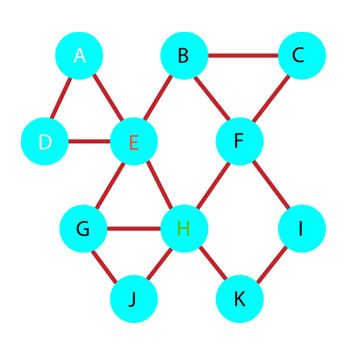Intro2 – The Social Network
Society, understood as a social network, is a structure of nodes tied to each other by specific modes of interdependency. It is important to note, that according to the social network analysis, the behavior of the structured units is not determined by socialization into the norms, but instead by the structure of the ties between the nodes. This is in high consistence with the view that it is not the individuals (such as persons, organisations and states), but the ties that are the primary constructive elements of a social structure. So that the analysis focuses on the ways in which the structure of ties affects the individuals and their relationship. This could lead to a structuralist analysis of a society, but the understanding of a network can also be lead to a non-structuralist way of deleuzian-guattarian rhizome.
There are various different ways in which nodes can be tied and various different ways a particular structure can be constructed. However, the ties as well as the structures and nodes can be measured on quantitative basis. The ties can be valued according to their strength, to stronger and weaker ties. Nodes are valued in different ways, such as their “degree”, “closeness” and “betweenness”: degree measures the number of actors of network to which a node is connected; closeness refers to the general distance of a particular individual to the others in network; betweenness is the extent to which a node lies in between other nodes, so that the ties between the other nodes run through this particular node. “Bridging” is an important factor when valuing the betweenness: a node is a bridge if it connects nodes that would otherwise belong to different components of a graph and an individual that lies in between actors that would not be tied or would only be very indirectly tied without this certain actor, can be valued qualitatively as very important parts of the network. Thus, the qualitative importance of a tie can be valued also by part it plays in a structure.
Structure can be measured in its connectedness: in an all-connected network all nodes are tied to all nodes, and more there are nodes that are not tied to each other, the less is the network connected. However, a network that is not all-connected can be constructed in many ways according to the degree and betweenness of particular nodes. It is also important to know, whether the network is directed or not: are the ties one way (like a hierarchic relation of giving orders), or two way (like a friendship relation). Usually the structure of a network consists of a combination of different ties and of different particular structure types.

E is the most between node. All the nodes are connected through it. A and D only are connected to the rest of the network through E, so E is also a bridge node. It is in an irreplaceable position, and depending on qualitative importance of A and D, it can be very important. Suppose that this would be a directed network instead, and the directions would come from A and D through E to rest of the network, and E would be in a very high strategic position. H is another particularly well positioned node, it is the most close node, only 2 steps from any other node in the network. H is not irreplaceable, but cut it out, and for example K would be connected to E through 4 steps, while it now takes 2 steps, F, now 2 steps away from J would also go 4 steps to link to it, and the distance between K and J, now 2 steps, would be as long as 6 steps. E and H have the largest number of direct links, 5, and thus the highest degrees. A, C, D, I, J and K only have 2 links each and thus the lowest degrees. To better understand the issue, take a look at few very distinct types of information networks.